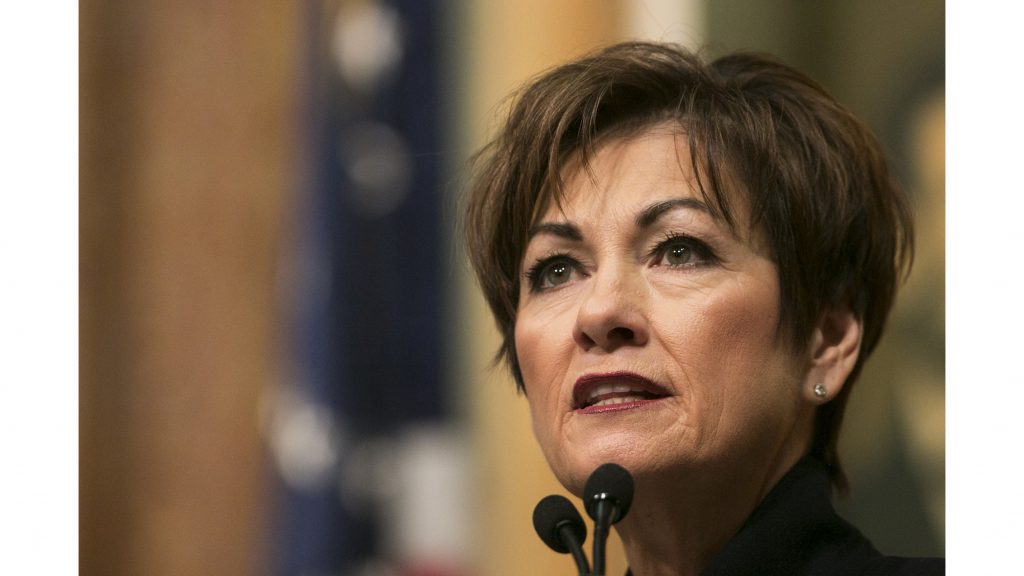Editorial: Reynolds should keep Iowa closed
The governor already put in place minimal restrictions, but it’s unwise to flout expert advice and ease up on closures too early.
Iowa Gov. Kim Reynolds speaks during her first Condition of the State address in the Iowa State Capitol in Des Moines on Tuesday, Jan. 9, 2018. Reynolds took over the governor office in May of 2017.
April 28, 2020
For a governor who has touted a data-driven approach to responding to the novel coronavirus pandemic, Kim Reynolds now flouts the experts.
The Des Moines Register on Tuesday broke the news that the Iowa Department of Public Health received white papers from the University of Iowa College of Public Health warning that a second wave of COVID-19 infections was likely if current efforts to mitigate the disease were lifted early.
The report stated that the researchers “have found evidence of a slowdown in infection and mortality rates due to social distancing policies, but not that a peak has been reached.” The researchers also cited cause for warning given the “considerable uncertainty” in the projected number of cases and deaths Iowans face, with possible projections ranging from 150 to more than 10,000 deaths.
“… Prevention measures should remain in place,” states the 12-page report’s conclusions. “Without such measures being continued, a second wave of infections is likely.”
Despite receiving the report some time “early last week,” the Iowa governor’s administration on Monday opted to instead take steps to reopen 77 of the state’s 99 counties starting Friday. Business closures remain in effect in the other 22 counties through at least May 15.
Reynolds’ move from stricter mitigation measures to targeted containment comes too early and may carry with it the high cost of thousands of Iowans’ lives.
As Gazette columnist Lyz Lenz put it in a Monday tweet, “The virus is spreading faster in Iowa than in any other state, but today @IAGovernor is opening up malls, restaurants and fitness centers in 77 counties because she wants to ‘get in front of the peak’ which is just like stepping on the gas so you can slow down for a red light.”
The virus is spreading faster in Iowa than in any other state, but today @IAGovernor is opening up malls, restaurants and fitness centers in 77 counties because she wants to “get in front of the peak” which is just like stepping on the gas so you can slow down for a red light
— Lyz Lenz (@lyzl) April 27, 2020
There’s so much we still don’t know about COVID-19, the disease caused by the coronavirus. It’s the safest for Iowa to remain largely closed at least until after the state hits its peak of cases and we see promising signs that new infections are tapering off.
Each day is bringing hundreds of new cases, with the highest one-day jump in cases occurring April 24 with 521 new cases. There are currently 5,868 confirmed cases in Iowa and 127 deaths. These spiking numbers are in part the result of increased and targeted testing towards areas of outbreaks, such as meat-packing plants and nursing homes.
Of course, the prolonged closures come with their own toll on the state economy. People, including our fellow UI students, are struggling to make their rent payments, put food on the table, and generally make ends meet as they grapple with lost jobs and opportunities to earn income.
The financial devastation cannot be overlooked in the response to this pandemic. Until there is more widespread availability of personal protective equipment and an even higher testing capacity — or, better yet, a COVID-19 treatment and vaccine — closures are perhaps the strongest method we have to ensure Iowans’ health and well-being. Current practices to encourage social distancing are still less restrictive than the types of shelter-in-place order that most other states have issued.
Reynolds’ administration should heed the warning from the UI experts — seven people with doctoral degrees, including Mike Pentella, the director of the State Hygienic Lab which started as the state’s only location to conduct COVID-19 tests.
Extended closures may devastate the economy, but lifting restrictions too soon could very likely result in a devastating loss of life. Our governor can’t put a price tag on Iowans’ lives.



